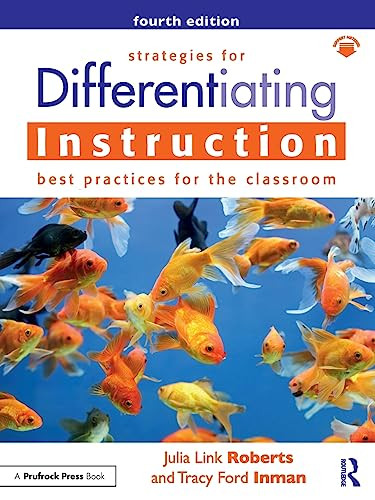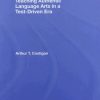(Ebook PDF) Strategies for Differentiating Instruction Best Practices for the Classroom 4th Edition by Julia Link Roberts, Tracy Ford Inman ISBN 9781000827378 1000827372 full chapters
$50.00 Original price was: $50.00.$35.00Current price is: $35.00.
Strategies for Differentiating Instruction Best Practices for the Classroom 4th Edition Julia Link Roberts Digital Instant Download
Author(s): Julia Link Roberts, Tracy Ford Inman
ISBN(s): 9781032354941, 1032354941
Edition: 4
File Details: PDF, 16.92 MB
Year: 2023
Language: english
SKU: EB-56971736
Category: Education Studies & Teaching - School Education & Teaching
Tags: Julia Link Roberts, Tracy Ford Inman
(Ebook PDF) Strategies for Differentiating Instruction Best Practices for the Classroom 4th Edition by Julia Link Roberts, Tracy Ford Inman -Ebook PDF Instant Download/Delivery:9781000827378, 1000827372
Instant download Full Chapter of Strategies for Differentiating Instruction Best Practices for the Classroom 4th Edition after payment

Product details:
ISBN 10:1000827372
ISBN 13:9781000827378
Author: Julia Link Roberts; Tracy Ford Inman
This updated edition of Strategies for Differentiating Instruction offers practical approaches that allow all students to make continuous progress and be appropriately challenged by focusing on their various levels of knowledge and readiness to learn. Written in an accessible, teacher-friendly style, chapters explore methods to tier learning experiences so that all students’ unique learning needs are met. The new edition updates the strategies complete with student examples and provides Developing and Assessing Products (DAP) tools for a variety of products as reproducible appendices. Full of research-supported examples and designed specifically for teachers who are new to differentiated instruction, this book offers vetted, practical advice for preassessing students, implementing differentiation strategies, and managing and assessing student learning. This new edition is a must read for teachers seeking to master the essentials on how to differentiate instruction and address all students’ needs, interests, and abilities.
Table of Contents:
- Chapter 1 One-Size-Fits-All? You’ve Got to Be Kidding!
- Differentiation: What Is It?
- To Differentiate or Not: The Big Question
- Reasons Teachers Don’t Differentiate
- Time
- Resources
- Limited Preparation
- Few Role Models
- Concerns With Classroom Management
- “Advanced Students Will Be Fine” Myth
- Lack of Administrators’ Knowledge of or Support for Differentiating
- Reasons to Differentiate
- Continuous Progress
- Productive Use of Student Time
- Stimulating to the Brain
- Fairness and Equity
- Not Differentiating: Missed Opportunities
- Differentiation Ties to Assessment
- Key Questions Leading to Differentiation
- What Differentiation Adds to the Classroom
- Who Benefits From Differentiated Learning Experiences and How?
- Chapter 2 Multiple Ways to Define Academic Success: What Resonates With You?
- Strategies to Enhance Academic Success
- Underachievement: The Problem From Limited Challenge
- Growth Mindset: Believing You Can Develop Your Talents and Abilities
- An Important Question for Educators and Parents
- Concluding Comments
- Chapter 3 Climate: Creating a Comfort Zone
- Climate of Differentiation
- Diversity and Equity
- High Expectations
- Openness and Flexibility
- Climate Matters for Learning and Creativity
- Concluding Thoughts
- Chapter 4 Content: Complex, Engaging, and Relevant
- Universal Themes
- Why Use Universal Themes?
- Other Themes
- Complex Content
- Complexity of Content
- Complexity of Process
- Engaging Content
- Relevant Content
- Standards-based Content
- Culturally Responsive Content
- Intellectual Character
- Concluding Thoughts
- Chapter 5 Preassessment: An Absolute Necessity
- Planning: The Necessary Step Before Preassessment
- Preassessment
- The Importance of Record Keeping
- What Students Need to Know Before You Preassess
- Preassessment as a Time Saver (Really!)
- Preassessment Strategies
- Existing Data
- End-of-the-Previous-Unit Assessment
- End-of-the-Unit Assessment
- T-W-H and K-W-L Charts
- Mind Map
- Most Difficult First
- Open-Ended Question or Questions
- Venn Diagram
- Interest and Experience Inventory
- Frayer Model
- Ready for Differentiation
- Chapter 6 Tiering to Facilitate Continuous Progress
- Tiering: A Familiar Example
- Levels of Readiness, Interests, and Strengths
- Content: What Students Must Know, Understand, and/or Be Able to Do
- Process: What Students Must Be Able to Do Cognitively
- Product: How Students Will Demonstrate or Show What They Have Learned
- Concluding Thoughts
- Chapter 7 Tiering Learning Experiences With Bloom’s Taxonomy
- How Can Bloom’s Taxonomy Be Used to Tier Assignments?
- A Critical Caveat
- What Does Tiering Look Like Using Bloom?
- When Do I Use It?
- Tiering to Differentiate Learning Experiences
- In-Class Activity
- Centers
- Unit Assessment
- Optional Learning Experiences
- How Do I Differentiate With the Bloom Chart?
- Develop Respectful, Engaging Tasks for Each Level
- Divide Tasks Into Choice Options and Then Purposely Assign Options
- Distribute Rubrics or Scoring Guides for Each
- Differentiating Through Process
- Concluding Comments
- Chapter 8 Tiering With Venn Diagrams
- What Is It?
- What Does It Look Like?
- When Do I Use It?
- Differentiating Process in an In-Class Learning Experience
- Individual and/or Group Activities
- Differentiating Process in an Out-of-Class Learning Experience
- Graphic Organizers for Prewriting
- Unit Review or Assessment
- How Do I Differentiate With Venn Diagrams?
- Decide the Focus of the Concept
- Hold All Students Responsible for That Concept – On Varying Levels
- Place Students by Level
- Allow Students to Try a More Challenging Level if Desired
- Distribute Rubrics or Scoring Guidelines
- Debrief
- A Point About the Four-Oval Venn
- What if Venn Diagrams Just Don’t Work for You?
- Concluding Thoughts
- Chapter 9 Think-Tac-Toe: An Effective Tool for Tiering
- What Is It?
- What Does It Look Like?
- When Do I Use It?
- Project to Accompany Unit
- Semester Reviews
- Unit Assessments
- How Else Can Think-Tac-Toes Be Used to Differentiate?
- Optional Learning Experiences
- Interests
- Learner Profile
- How Do I Differentiate With Think-Tac-Toes?
- Experiment With a Favorite Lesson
- Creating Think-Tac-Toes for the Classroom
- Incorporate Important Concepts Into Three (or More OR FEWER) Rows
- Design Tasks With Varied Products
- Hold Everyone Responsible for Important Concepts
- Allow Students to Choose One From Each Row/Concept
- Distribute Rubrics or Scoring Guides and Allow for Variations
- Assess the Products
- Concluding Thoughts
- Chapter 10 Managing the Differentiated Classroom
- Managing Student Grouping
- Ineffective Grouping Strategies: Tracking and Mixed-Ability Groups
- Tracking
- Mixed-Ability Grouping
- Effective Grouping Strategies
- Teacher-Created Groups
- School-Created Groups
- Keys to Successful Grouping
- Managing the Classroom
- Getting Into Groups
- Managing Groups
- Managing Materials
- Managing Time
- Chapter 11 Taming the Assessment Beast
- Authentic Assessment
- Products
- Rubrics/Scoring Guides
- Developing and Assessing PRODUCTS Tool (DAP Tool)
- DAP TOOL Components
- A Performance Scale for the DAP Tool That Goes Beyond Proficiency
- Three Tiers to Differentiate
- Content Validity of the DAP Tool
- DAP Tools for Primary Students
- Grading With DAP Tools
- Concluding Thoughts
- Chapter 12 Reflection: An Essential Practice for Lifelong Learning
- Reflecting on Content, Product, and Effort
- Reflecting on Content
- Reflecting on Product
- Reflecting on Individual Effort
- Reflection Using the DAP Tool
- Other Examples of Ways to Reflect
- Discussing
- Journaling
- Student Example of Reflection
- Concluding Thoughts
- Chapter 13 A Differentiation Fable: Fable Contributed by Mandy Simpson
- References
- Appendix A: What a Child Doesn’t Learn …: By Tracy Inman
- References
- Appendix B: Directions for Activity: How Do You Learn It?
- Appendix C: My Way … An Expression Style Inventory
- Appendix D: Interest Inventory
- Appendix E: Bloom Chart Template
- Appendix F: Venn Diagrams
- Appendix G: Letters and Boxes
- Appendix H: Think-Tac-Toe Template
- Appendix I: Developing and Assessing Products (DAP) Tools
- Appendix J: Building Support for Differentiation: Hard But Not Impossible to Do Alone
People also search:
research based strategies for differentiating instruction
low prep strategies for differentiating instruction
strategies for differentiating instruction best practices for the classroom
strategies for differentiating instruction in the content areas
differentiating instruction in the inclusive classroom strategies for success
Tags:
Julia Link Roberts,Tracy Ford Inman,Strategies,Differentiating Instruction


